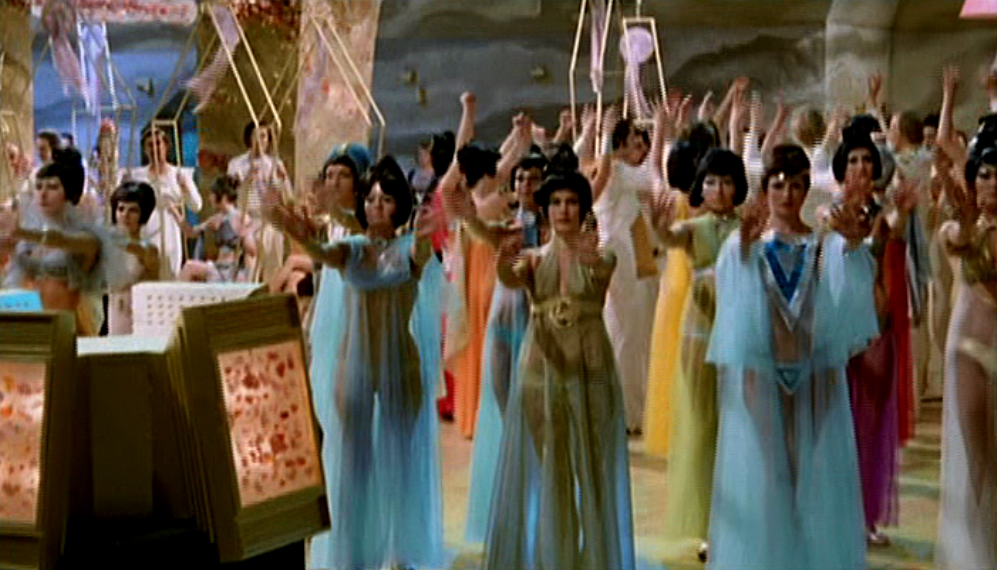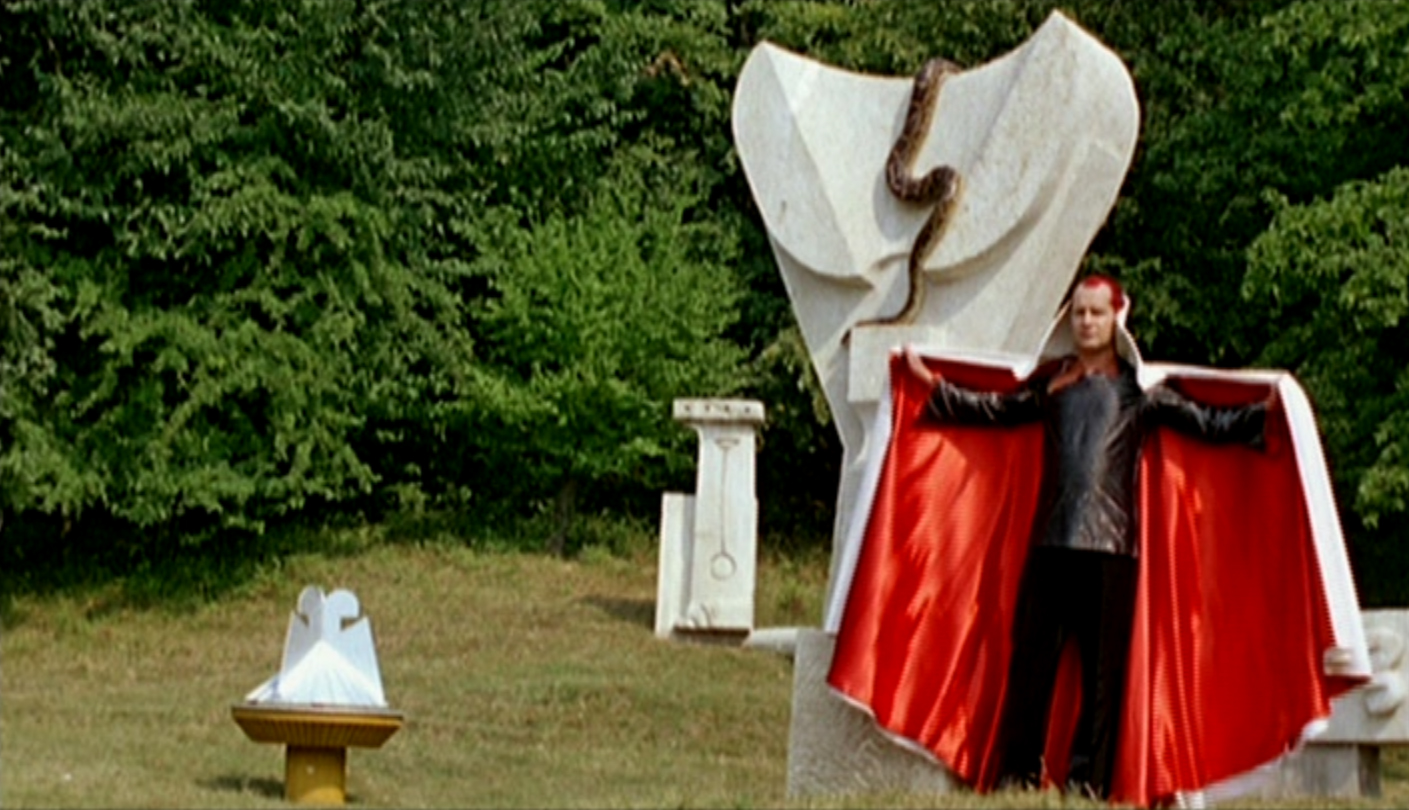If I was to choose the one film that got me interested in East German Cinema, it would have to be this one. Sometimes referred to as the “East German Barbarella,” In the Dust of the Stars (Im Staub der Sterne) is one of the strangest film to grace the movie screens of the GDR; or anywhere else for that matter. Featuring a cast that heralded from a number of different eastern European countries, In the Dust of the Stars is the story of a space team sent from the Planet Cyrno in response to a distress call on TEM 4, a desolate planet on the outskirts of inhabited space. When they arrive, they are whisked off to an extravagant compound belonging to a man known only as the “Chief”—a decadent despot who has enslaved the indigenous people of TEM 4 for his own profit and enjoyment. The team is invited to a party that features dancing maidens in an art park, boa constrictors on the hors d’oeuvre table, and a screaming woman on a trampoline. At the party, the team is brainwashed into assuming that nothing is wrong on the planet, but the one crew member that skipped the party remains sceptical. He thinks something is amiss and he is, of course, correct.
DEFA made four outer-space films. In the Dust of the Stars was the fourth and final one. Unlike the three previous films (The Silent Star, Signals, and Eolomea), In the Dust of the Stars is not based on a book. The original screenplay was written by the director, Gottfried Kolditz. Kolditz got his start in the fifties working as a musical advisor on The Love Mazurka (Mazurka der Liebe) and The Czar and the Carpenter (Zar und Zimmermann). He started directing shortly thereafter, at first working on the short comedy films for the Statcheltier group, and then on musicals. He directed Midnight Revue and Beloved White Mouse—two of the most popular musicals in East Germany. In the late sixties, he moved into other genres, directing two science fiction films (Signals and In the Dust of the Stars) and three Indianerfilme (The Falcon’s Trail, Apaches, and Ulzana). Kolditz died in 1982, shortly before he was to begin filming yet another Indianerfilm (Der Scout).
The music score is by Karl-Ernst Sasse, one of the most accomplished, and prolific composers in East Germany (see Her Third, for more information on Sasse). Kolditz and Sasse worked together often, beginning with Midnight Revue in 1962 and continuing until Koldtitz’s death in 1982. Considering Kolditz’s start as a musical advisor for DEFA films, it is no surprise that he would make movies in which the music is an important component. What is surprising is that he would choose a science fiction film to continue his exploration of the subject (although there are good reasons for this, and I’ll be covering them in my review of Signals). In an interview with the cinematographer, Peter Süring, Süring opines that the nude musical number performed by Regine Heintze is superfluous to the narrative; but this opinion assumes that the obvious story (that of the oppressed people of TEM 4) is the primary point of the movie. Perhaps Kolditz was after something more complex here. Music figures prominently throughout the film. The eccentric Chief seems to need music at all times, and is unable to think without it, and it is music that is used to hypnotize the spaceship’s crew into ignoring the warning signals they received earlier.
Sasse’s score varies from jazzy pop à la Can’s Tago Mago, to abstract numbers resembling the electronica of Beaver & Krause. Most of the time, the music is combined with modern dance numbers performed by a bevy of heavily made-up women in colorful harem costumes. In one memorable scene, The Chief (whose hair color changes in every scene) serenades Akala, the spaceship’s captain, in a hall of mirrors filled with the usual dancing women. The Chief performs this number on a musical instrument that looks like exactly what it is: a board covered with Christmas lights. Like the nude dancing scene, it does nothing to move to plot forward and further bolsters the effect that In the Dust of the Stars is really a musical revue that has been interrupted by a slave revolt.
At other times, it resembles a western. When we first see Chta, the Temian slave of the evil overseer, Ronk, she is dressed in a Native American outfit that looks like it was borrowed —and probably was—from one of the Gojko Mitic Indianerfilme. The effect is further enhanced by the appearance of Milan Beli as Ronk. Beli had already impressed East German audiences with his performance as a villains in Tecumseh, and Apachen, and he is no less villainous here. The climax of In the Dust of the Stars features a shoot-out on mud flats that would have been at home in any western on either side of the iron curtain.
The film was a co-production between DEFA and the Buftea Film Studios near Bucharest. The location shots were done in Romania first, primarily at the Berca Mud Volcanoes and an abandoned salt mine nearby. At that time, DEFA was using ORWOcolor, the East German version of AGFAcolor. Romania, on the other hand, was using Kodak’s Eastmancolor. When it came time to develop the first batch of film, the Buftea studios had to modify their equipment to handle the ORWOcolor film. The finished film had a softer contrast than usual, and Wolfgang Staudte liked the look of it. After the production moved back to Babelsberg for the in-studio filming, Staudte had all the film sent to Buftea for processing. This forced the movie to work at a slower pace than usual since dailies weren’t possible. To speed things up, DEFA set up a hotline between Buftea and Babelsberg in case of emergencies.
1978, the year that In the Dust of the Stars came out, was one of those pivotal years in East German cinema. Two years earlier, the officials had exiled the popular folk singer Wolf Biermann while he was performing in Cologne. Although he was an ardent communist, his criticisms of the Stalinist policies in the GDR stirred the wrath (or, as he suggested, the terror) of party officials and they thought it would be better if he just didn’t come home. This provoked protests, particularly in the arts community, and eventually led to some of the the strongest lights at DEFA to cross over to the west, among them, Frank Beyer, Jutta Hoffmann, Angelica Domröse, and Armin Mueller-Stahl. For many of these people, 1978 was the last year that we would see them in East German films (and some, like Rolf Römer, stayed in the east, but were effectively blacklisted because of their pro-Biermann stance). Conversely, 1978 is also the year that afforded the most artistic freedom to filmmakers in terms of style and subject matter. Had In the Dust of the Stars been made in 1965, it would have almost certainly been banned; the same holds true for Egon Günther’s 1978 made-for-TV oddity, Ursula (although after only one screening, Ursula did manage to get itself banned not only in East Germany but also in Switzerland). In these films we see the ultimate examples of cinematic experimentation at DEFA. From here until the Wende, mainstream movies in East Germany would never again reach this level of oddball imaginativeness.
© Jim Morton and East German Cinema Blog, 2021. Unauthorized use and/or duplication of this material without express and written permission from this site’s author and/or owner is strictly prohibited. Excerpts and links may be used, provided that full and clear credit is given to Jim Morton and East German Cinema Blog with appropriate and specific direction to the original content.




